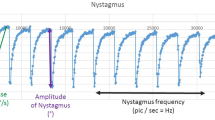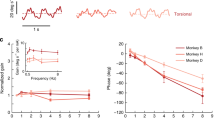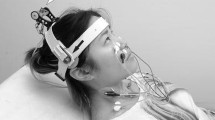Summary
The responses of vestibular nuclei neurons of relaxed unaesthetized goldfish have been examined with trapezoid velocity stimuli under three conditions.
Responses to horizontal body rotation in the dark (pure vestibular stimulation) resemble those observed in vestibular nerve afferents.
Optokinetic responses to exclusive visual surround-motion are also direction-specific and, in contrast to vestibular responses, exhibit a tonic response to constant velocity. They show three different response profiles, classified A, B or C, based on the neuron's discharge rate: either increasing, decreasing or remaining constant once surround motion is maintained at constant velocity. Following these dynamic effects, optokinetic responses have a maintained modulation of resting discharge until deceleration commences. The time constants associated with the dynamic effects vary between 1 and 11 seconds. Steady-state modulation of optokinetic responses shows a weak relation to stimulus velocities exceeding 10 deg/sec.
Responses to body rotation in the light were found to linearly combine the weighted vestibular and optokinetic responses so that accurate velocity information is available for sensory and motor functions independent of the neuron's vestibular (I, II) or optokinetic (A, B, C) response type. The principle of this visual-vestibular interaction is discussed with respect to multisensory processing within the vestibular nuclei.
Similar content being viewed by others
References
Adrian, E.D.: Discharges from vestibular receptors in the cat. J. Physiol. (Lond.) 101, 384–407 (1943)
Ariens Kappers, C.U., Huber, G.C., Crosby, E.C.: The Comparative Anatomy of the Nervous System of Vertebrates Including Man. Vol. 1, p. 455. New York: Hafner Press 1965
Azzena, G.B., Azzena, M.T., Marini, R.: Optokinetic nystagmus and the vestibular nuclei. Exp. Neurol. 42, 158–168 (1974)
Baarsma, E.A., Collewijn, H.: Vestibulo-ocular and optokinetic reactions to rotation and their interaction in the rabbit. J. Physiol. (Lond.) 238, 603–625 (1974)
Barlow, H.B., Hill, R.M., Levick, W.R.: Retinal ganglion cells responding selectively to direction and speed of image motion in the rabbit. J. Physiol. (Lond.) 173, 377–407 (1964)
Bizzi, E., Pompeiano, O., Somogyi, J.: Spontaneous activity of single vestibular neurons of unrestrained cats during sleep and wakefulness. Arch. ital. Biol. 102, 308–330 (1964)
Brandt, T., Dichgans, J., Koenig, E.: Differential effects of central versus peripheral vision on egocentric and exocentric motion perception. Exp. Brain Res. 16, 476–491 (1973)
Cronly-Dillon, T.R.: Units sensitive to direction of movement in goldfish optic tectum. Nature (Lond.) 203, 214–215 (1964)
Dichgans, J., Schmidt, C.L., Graf, W.: Visual input improves the speedometer function of the vestibular nuclei in the goldfish. Exp. Brain Res. 18, 319–322 (1973)
Duensing, F., Schaefer, K.P.: Die Aktivität einzelner Neurone im Bereich der Vestibulariskerne bei Horizontalbeschleunigungen unter besonderer Berücksichtigung des vestibulären Nystagmus. Arch. Psychiat. Nervenkr. 198, 225–252 (1958)
Easter, S.S.: Pursuit eye movements in goldfish. Vision Res. 12, 673–688 (1972)
Fernandez, C, Goldberg, J.M.: Physiology of peripheral neurons innervating semicircular canals of the squirrel monkey. II. Response to sinusoidal stimulation and dynamics of peripheral vestibular system. J. Neurophysiol. 34, 661–675 (1971)
Fischer, M.H., Kornmüller, A.E.: Optokinetisch ausgelöste Bewegungswahrnehmungen und optokinetischer Nystagmus. J. Psychol. Neurol. (Lpz.) 41, 383–420 (1930)
Flock, A., Russell, I.J.: The post-synaptic action of efferent fibers in the lateral line organ of the burbot Lota Lota. J. Physiol. (Lond.) 255, 591–605 (1973)
Galley, N., Klinke, R., Pause, M., Storch, W.-H.: The effect of Flaxedil (Gallamine triethiodide) on the efferent endings in the cochlea. Pflügers Arch. 330, 1–4 (1971)
Galley, N., Klinke, R., Oertel, W., Pause, M., Storch, W.-H.: The effect of intracochlearly administered acetylcholone-blocking agents on the efferent synapsis of the cochlea. Brain Res. 64, 55–63 (1973)
Gardner, E.P., Fuchs, A.F.: Single unit response to natural vestibular stimuli and eye movements in deep cerebellar nuclei of the alert rhesus monkey. J. Neurophysiol. 38, 672–649 (1975)
Ghelarducci, B., Ito, M., Yagi, N.: Impulse discharges from flocculus Purkinje cells of alert rabbits during visual stimulation combined with head rotation. Brain Res. 87, 66–72 (1975)
Gleisner, L., Henriksson, N.G.: Efferent and afferent activity pattern in the vestibular nerve of the frog. Acta oto-laryng. (Stockh.) Suppl. 192, 90–103 (1963)
Goldberg, J.M., Fernandez, C.: Physiology of peripheral neurons innervating semicircular canals of the squirrel monkey. I. Resting discharge and response to constant angular accelerations. J. Neurophysiol. 34, 635–660 (1971)
Graf, W.: Optokinetische Interactionen mit Spontanverhalten und Beschleunigungsreaktion von Vestibulariskernneuronen beim Goldfisch. M.D. Thesis, University of Freiburg 1976
Hartmann, R., Hasenpusch, U., Klinke, R.: Properties of afferent neurons of the goldfish semi-circular canal under sinusoidal rotatory stimulation. Pflügers Arch. Suppl. 343, R.71 (1973)
Hartmann, R., Klinke, R.: System analysis of properties of primary vestibular fibers. Exp. Brain Res. Suppl. 23, 165 (1975)
Henn, V., Young, L.R., Finley, C.: Vestibular nucleus units in alert monkeys are also influenced by moving visual fields. Brain Res. 71, 144–149 (1974)
Jacobson, M., Gaze, R.M.: Types of response from single units in the optic tectum and optic nerve of the goldfish. Quart. J. exp. Physiol. 49, 199–209 (1964)
Keller, E.L., Daniels, P.D.: Oculomotor related interaction of vestibular and visual stimulation in vestibular nucleus cells in alert monkey. Exp. Neurol. 46, 187–198 (1975)
Klinke, R., Schmidt, C.L.: Efferent influence on the vestibular organ during active movements of the body. Pflügers Arch. 318, 325–332 (1970)
Kubo, T., Matsunaga, T., Matano, S.: Effects of sinusoidal rotational stimulation on the vestibular neurons of rats. Brain Res. 88, 543–548 (1975)
Maekawa, K., Simpson, J.I.: Climbing fiber responses evoked in the vestibulo-cerebellum of rabbit from visual system. J. Neurophysiol. 36, 649–666 (1973)
Mehler, W.R.: Comparative anatomy of the vestibular nuclear complex in submammalian vertebrates. In: Progress in Brain Research. Vol. 37, Basic Aspects of Central Vestibular Mechanisms. (A. Brodal, O. Pompeiano, Eds.), pp. 56–67. Amsterdam: Elsevier 1972
Precht, W., Llinas, R., Clarke, M.: Physiological responses of frog vestibular fibers to horizontal angular rotation. Exp. Brain Res. 13, 378–407 (1971)
Shimazu, H., Precht, W.: Tonic and kinetic responses of cats vestibular neurons to horizontal angular rotation. J. Neurophysiol. 28, 991–1013 (1965)
Shimazu, H., Precht, W.: Inhibition of central vestibular neurons from the contralateral labyrinth and its mediating pathway. J. Neurophysiol. 29, 467–492 (1966)
Simpson, J.I., Alley, K.E.: Visual climbing fiber input to rabbit vestibulo-cerebellum: a source of direction-specific information. Brain Res. 82, 302–308 (1974)
Steinhausen, W.: Über den Nachweis der Bewegung der Cupula in der intakten Bogengangsampulle des Labyrinthes bei der natürlichen rotatorischen und colorischen Reizung. Arch. Ges. Physiol. 228, 322–328 (1931)
Steinhausen, W.: Über die Beobachtung der Cupula in der Bogengangsampulle des Labyrinths des lebenden Hechts. Arch. Ges. Physiol. 232, 500–512 (1933)
Wartok, D., Marks, W.B.: Directionally selective visual units recorded in the optic tectum of the goldfish. J. Neurophysiol. 36, 588–604 (1973)
Author information
Authors and Affiliations
Rights and permissions
About this article
Cite this article
Allum, J.H.J., Graf, W., Dichgans, J. et al. Visual-vestibular interactions in the vestibular nuclei of the goldfish. Exp Brain Res 26, 463–485 (1976). https://doi.org/10.1007/BF00238821
Received:
Issue Date:
DOI: https://doi.org/10.1007/BF00238821




